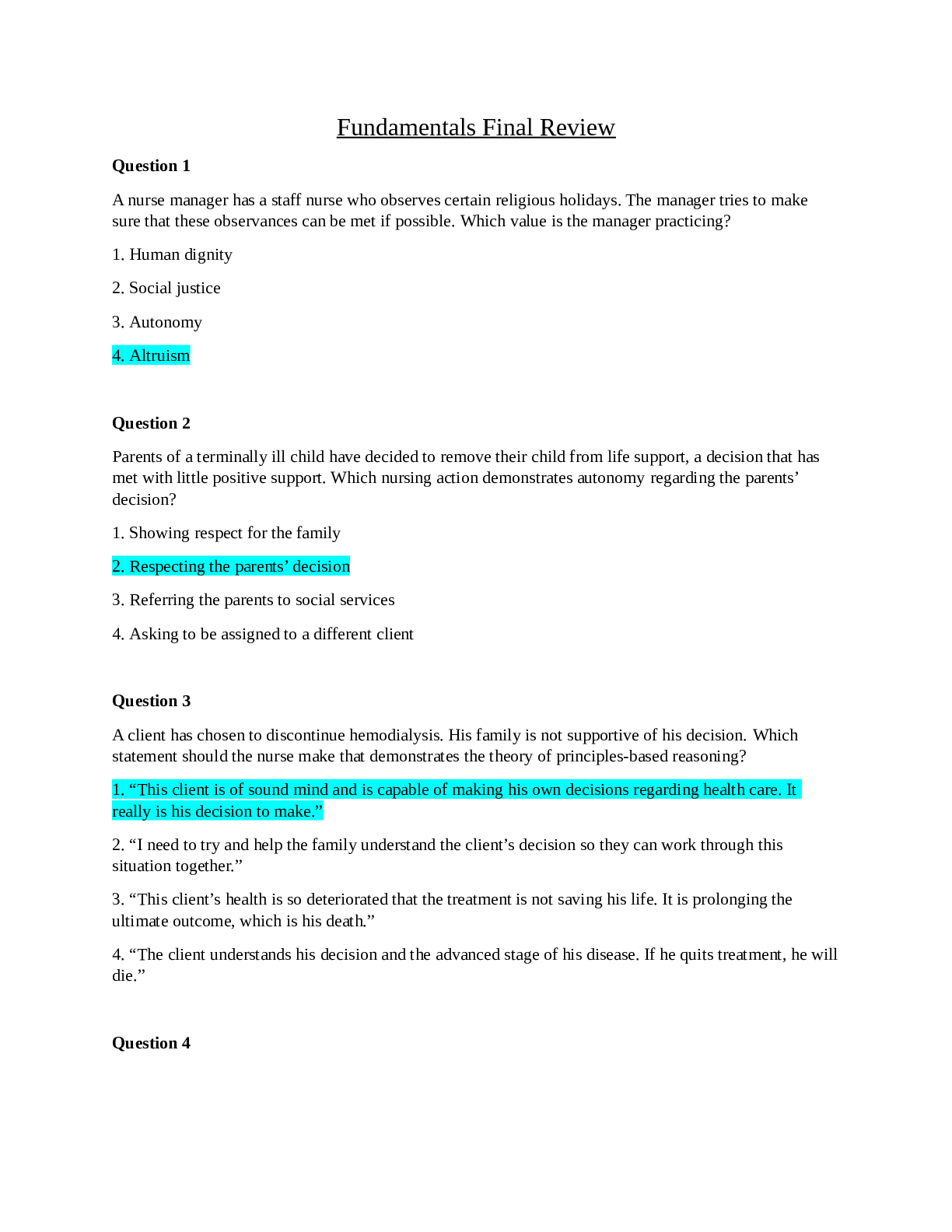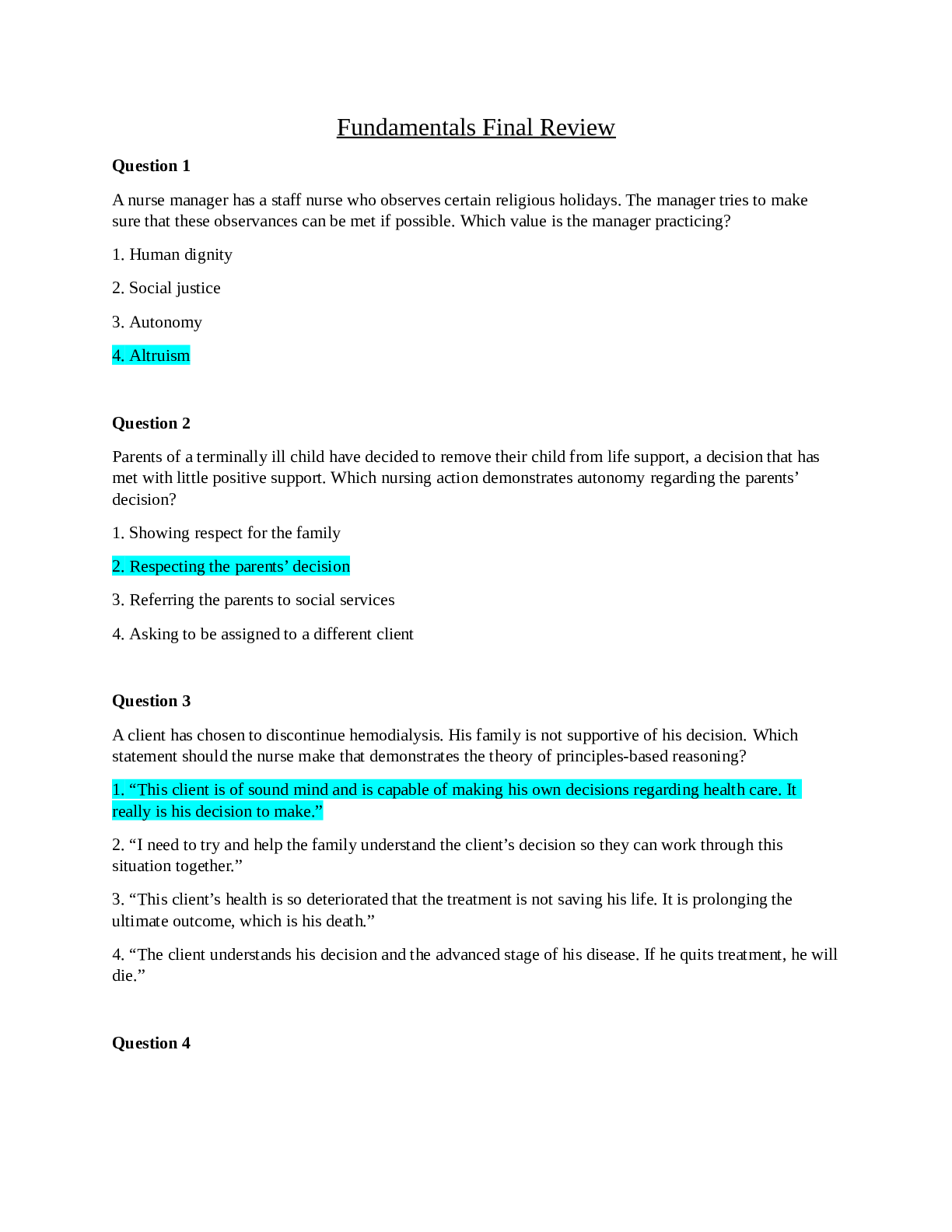Health Care > EXAM > Keiser University> NUR 1022C Fundamentals Final Review/ NUR-1022C Fundamentals Final Review; Complet (All)
Keiser University> NUR 1022C Fundamentals Final Review/ NUR-1022C Fundamentals Final Review; Complete Answered (all)
Document Content and Description Below
Fundamentals Final Review Question 1 A nurse manager has a staff nurse who observes certain religious holidays. The manager tries to make sure that these observances can be met if possible. Which valu... e is the manager practicing? 1. Human dignity 2. Social justice 3. Autonomy 4. Altruism Question 2 Parents of a terminally ill child have decided to remove their child from life support, a decision that has met with little positive support. Which nursing action demonstrates autonomy regarding the parents’ decision? 1. Showing respect for the family 2. Respecting the parents’ decision 3. Referring the parents to social services 4. Asking to be assigned to a different client Question 3 A client has chosen to discontinue hemodialysis. His family is not supportive of his decision. Which statement should the nurse make that demonstrates the theory of principles-based reasoning? 1. “This client is of sound mind and is capable of making his own decisions regarding health care. It really is his decision to make.” 2. “I need to try and help the family understand the client’s decision so they can work through this situation together.” 3. “This client’s health is so deteriorated that the treatment is not saving his life. It is prolonging the ultimate outcome, which is his death.” 4. “The client understands his decision and the advanced stage of his disease. If he quits treatment, he will die.” Question 4A decision has been made for an older client to receive aggressive cancer therapy despite knowing that the therapy will actually be more harmful than the disease and subject the client to harmful chemicals. With which ethical principle is this nurse caring for this client struggling? 1. Autonomy 2. Justice 3. Beneficence 4. Nonmaleficence Question 5 When completing a community assessment, the community health nurse will take several aspects into account. What is the first stage of this assessment that the nurse will complete? 1. Learn about the people in the community. 2. Understand the major illnesses present in the community. 3. Identify the boundaries of the community. 4. Make sure resources are available in the community. Question 6 A public health nurse is working with a group of home health nurses in an isolated, mountainous region where access to smaller communities and individuals is quite difficult, especially in the winter and early spring—seasons when the health needs of these individuals are quite high. The public health nurse has set up video conferencing and video clinics for these home health nurses regarding various client teaching and health promotion activities. What activity did the public health nurse conduct? 1. Community-based nursing 2. Parish nursing 3. Telenursing 4. Collaborative health care Question 7 The nurse is providing care to a group of clients. For which situation would the nurse’s use of critical thinking be a priority? 1. Administering IV push meds to critically ill clients 2. Educating a home health client about treatment options 3. Teaching new parents car seat safety4. Assisting an orthopedic client with the proper use of crutches Question 8 A client is experiencing a productive cough, audible coarse crackles, elevated temperature of 102.3°F, chills, and body aches. What did the nurse use to determine that this patient is experiencing respiratory compromise? 1. Deductive reasoning 2. Inductive reasoning 3. Socratic questioning 4. Critical analysis Question 9 The nurse who just moved from an urban area to a sparsely populated rural area understands that certain customs and practices the nurse follows may be quite foreign to the people in the new area. Which attitude of critical thinking is the nurse demonstrating? 1. Fair-mindedness 2. Insight into egocentricity 3. Intellectual humility 4. Intellectual courage to challenge the status quo and rituals Question 10 The nurse implements a quicker way to set up and initiate an intravenous infusion while still following safe practice. Which attitude of critical thinking is this nurse practicing? 1. Independence 2. Intellectual courage to challenge the status quo or rituals 3. Integrity 4. Confidence Question 11 The student is learning the steps of the nursing process. What is the first thing that the student should realize about the purpose of this process? 1. Deliver care to a client in an organized way.2. Implement a plan that is close to the medical model. 3. Identify client needs and deliver care to meet those needs. 4. Make sure that standardized care is available to clients. Question 12 The nurse provides a back rub to a client after administering a pain medication with the hope that these two actions will help decrease the client’s pain. Which phase of the nursing process is this nurse implementing? 1. Assessment 2. Diagnosis 3. Implementation 4. Evaluation Question 13 The nurse is admitting an infant to the care area. The parents and grandmother are present. What should the nurse use as the best source of data for this client? 1. Medical record from the child’s birth 2. Grandmother 3. Parents 4. Admitting physician Question 14 The nurse documents: “Client avoids eye contact and gives only vague, nonspecific answers to direct questioning by the professional staff. Is quite animated (laughs aloud, smiles, uses hand gestures) in conversation with spouse.” Which method of data collection does this documentation demonstrate? 1. Examining 2. Interviewing 3. Listening 4. Observing Question 15A discharge goal for a client is to have improved mobility. Which outcome statement did the nurse write appropriately? 1. Client will ambulate without a walker by 6 weeks. 2. Client will ambulate freely in house. 3. Client will not fall. 4. Client will have freer movement in daily activities. Question 16 The nurse is reviewing interventions written for a client’s plan of care. Which intervention should the nurse recognize as being dependent? 1. Repositioning the client every 2 hours 2. Assisting the client with transfers to the bathroom 3. Providing ongoing physical assessment, especially of the incisional sites 4. Administering medications for pain Question 17 The nurse identifies the diagnosis Risk for aspiration, related to neuromuscular dysfunction for a client who experienced a cerebrovascular accident. Which intervention should the nurse identify as including a rationale? 1. Have suction equipment available at all times. 2. Clear secretions from oral/nasal passageways as needed. 3. Keep client in low-Fowler’s position to prevent reflux. 4. Provide frequent assessment for presence of obstructive material in mouth and throat. Question 18 A client who is being transferred to a rehabilitation center asks the nurse if he can take his chart with him, as it’s his record. How should the nurse respond to this client’s request? 1. “You’ll have to ask your doctor for permission to do that.” 2. “Actually, the original record is the property of the hospital, but you are welcome to copies of your records.” 3. “We’ll make sure that all of your records are sent ahead to the rehab hospital, so you don’t really have to worry about those details.”4. “There’s a new law that protects your records, so you’re not going to be able to have access to them.” Question 19 After classroom discussion regarding confidentiality policies and laws protecting client records, a student asks why it’s permissible for them to review and have access to client records in the clinical area. How should the nursing instructor respond? 1. “Confidentiality and privacy laws don’t apply to students.” 2. “Most students review so many records and charts that they could not possibly remember details from any one of them.” 3. “Records are used in educational settings and for learning purposes, but the student is bound to hold all information in strict confidence.” 4. “As long as the clinical instructor is in the area, accessing client records is part of the education process.” Question 20 The client states: “I really don’t want anyone to visit me who has not been cleared by me first.” If utilizing SOAP format, in which category should the nurse document this statement? 1. Subjective data 2. Objective data 3. Assessment 4. Planning Question 21 A client did not meet the goal of walking unassisted, without assistive devices, by discharge from rehabilitation. The case manager using a critical pathway should identify this outcome as being which of the following? 1. An unattainable goal 2. A variance 3. An error in care planning 4. An error in intervention implementation Question 22When responding to a call light, the nurse finds a client lying on the floor, with the bed linens around the legs. Which chart entry should the nurse document for this finding? 1. Client fell out of bed, but did push the call button for assistance. 2. Client became tangled in the bed linens, then called for assistance after falling out of bed. 3. Recorder responded to client’s call light, upon entering the room, found client on floor. 4. Client found on floor, appeared to have fallen out of bed as a result of getting tangled in bed linens. Question 23 A nurse is working in a rehabilitation center with a client who had a serious injury. Part of the client’s care plan includes working on coping with her current limitations since the injury. This nurse is working within which model of health? 1. Role performance 2. Adaptive 3. Eudemonistic 4. Clinical Question 24 During a home visit with a new community member, the nurse suspects that a client has a chronic illness. What did the nurse assess to make this clinical decision? Select all that apply. 1. Experienced symptoms for 8 months 2. Has periods where the symptoms disappear 3. Altered activities of daily living because of the illness 4. Problem disappeared with over-the-counter medication 5. Symptoms appeared abruptly and disappeared after treatment Question 25 A community health nurse is learning about the REACH initiative and has decided to implement community education on this approach. What topics should the nurse include in this education? Select all that apply. 1. Child and adult immunizations 2. Cardiovascular disease 3. Chronic lower respiratory disease4. Stroke 5. Infant mortality Question 26 A client is the child of an African American father and Asian American mother. The client has been exposed to cultural foods, traditions, and customs from both parents throughout life. What term should the nurse use to describe this client’s cultural development? [Show More]
Last updated: 1 year ago
Preview 1 out of 39 pages
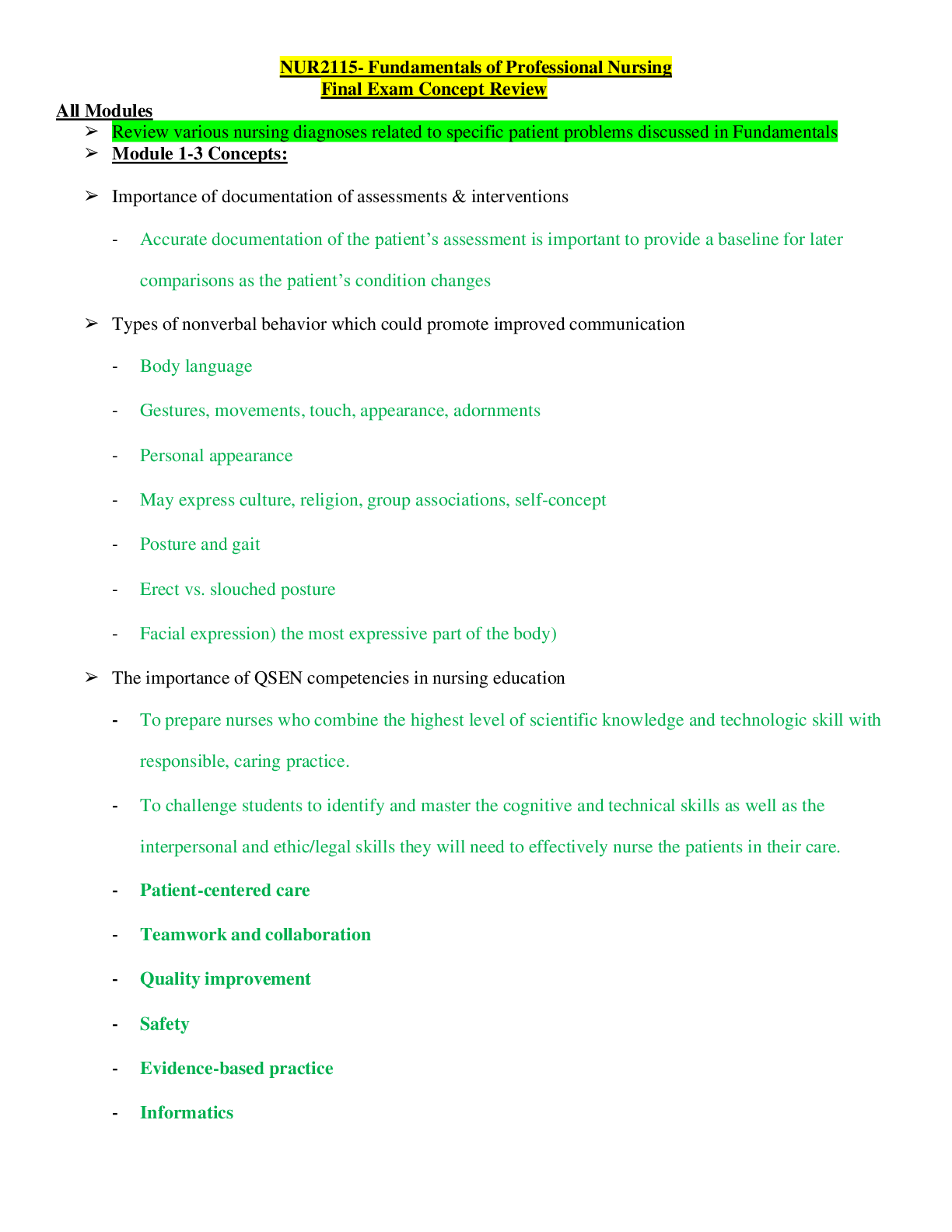
Buy this document to get the full access instantly
Instant Download Access after purchase
Add to cartInstant download
We Accept:

Reviews( 0 )
$13.00
Document information
Connected school, study & course
About the document
Uploaded On
Aug 29, 2022
Number of pages
39
Written in
Additional information
This document has been written for:
Uploaded
Aug 29, 2022
Downloads
0
Views
178




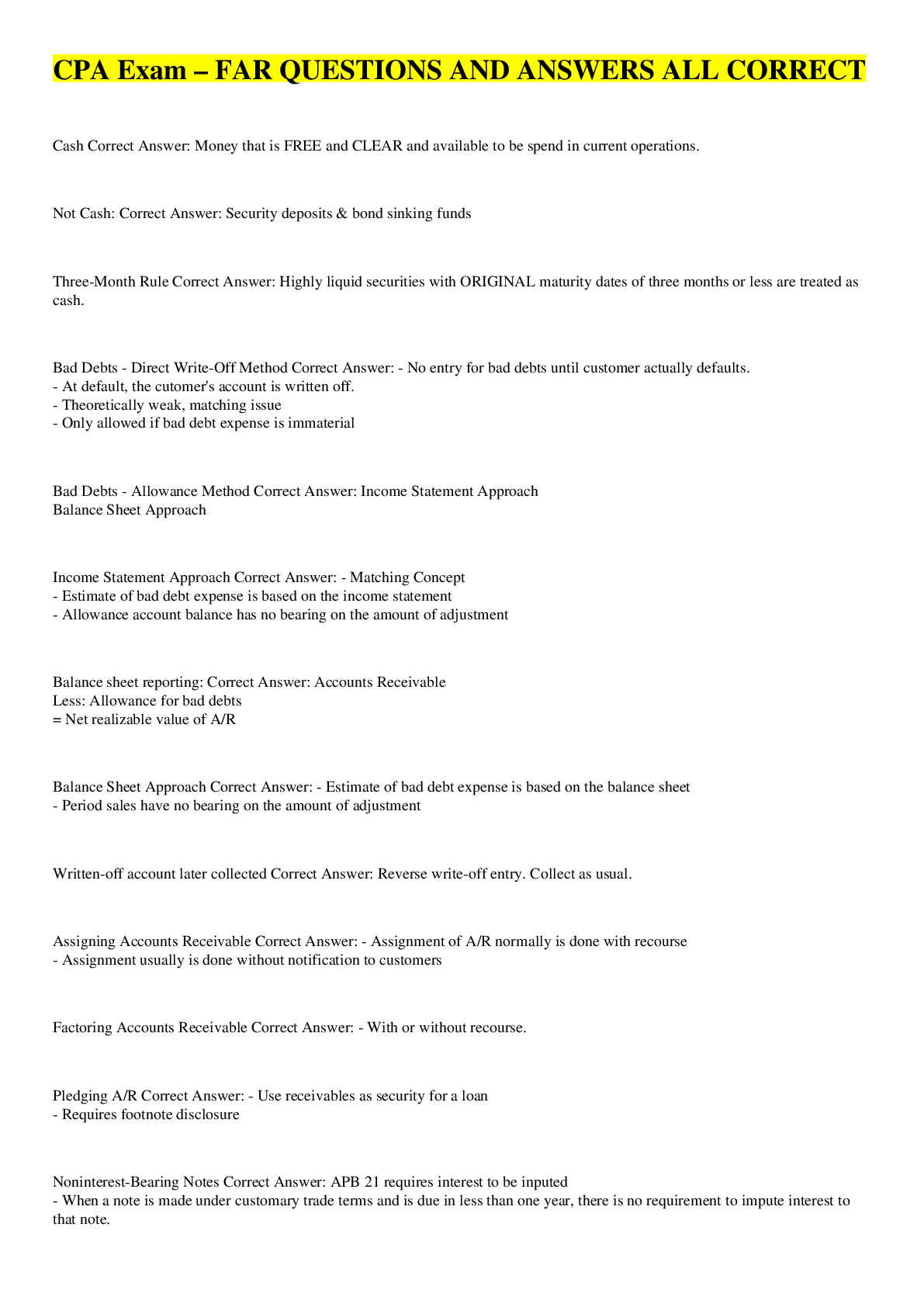
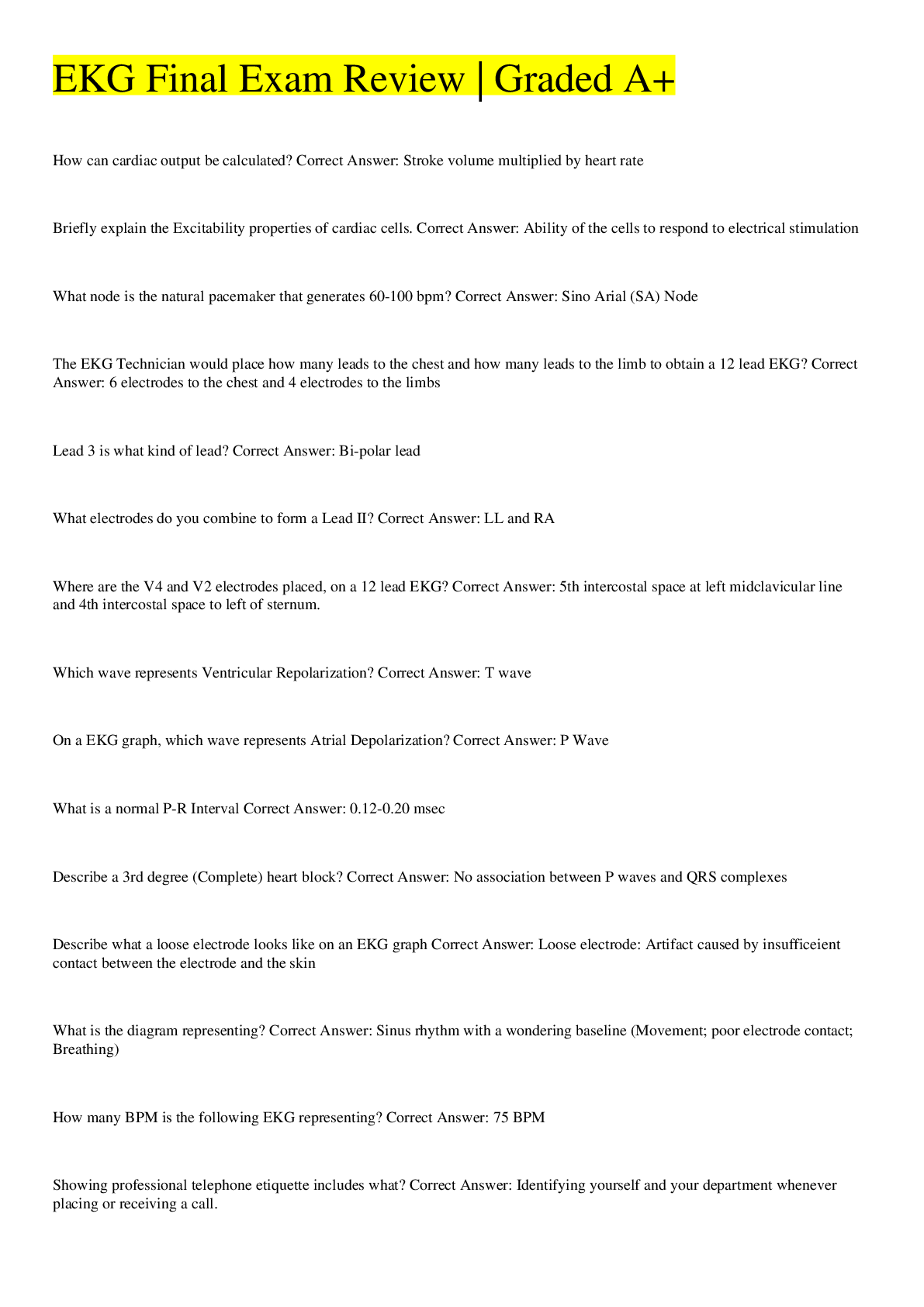

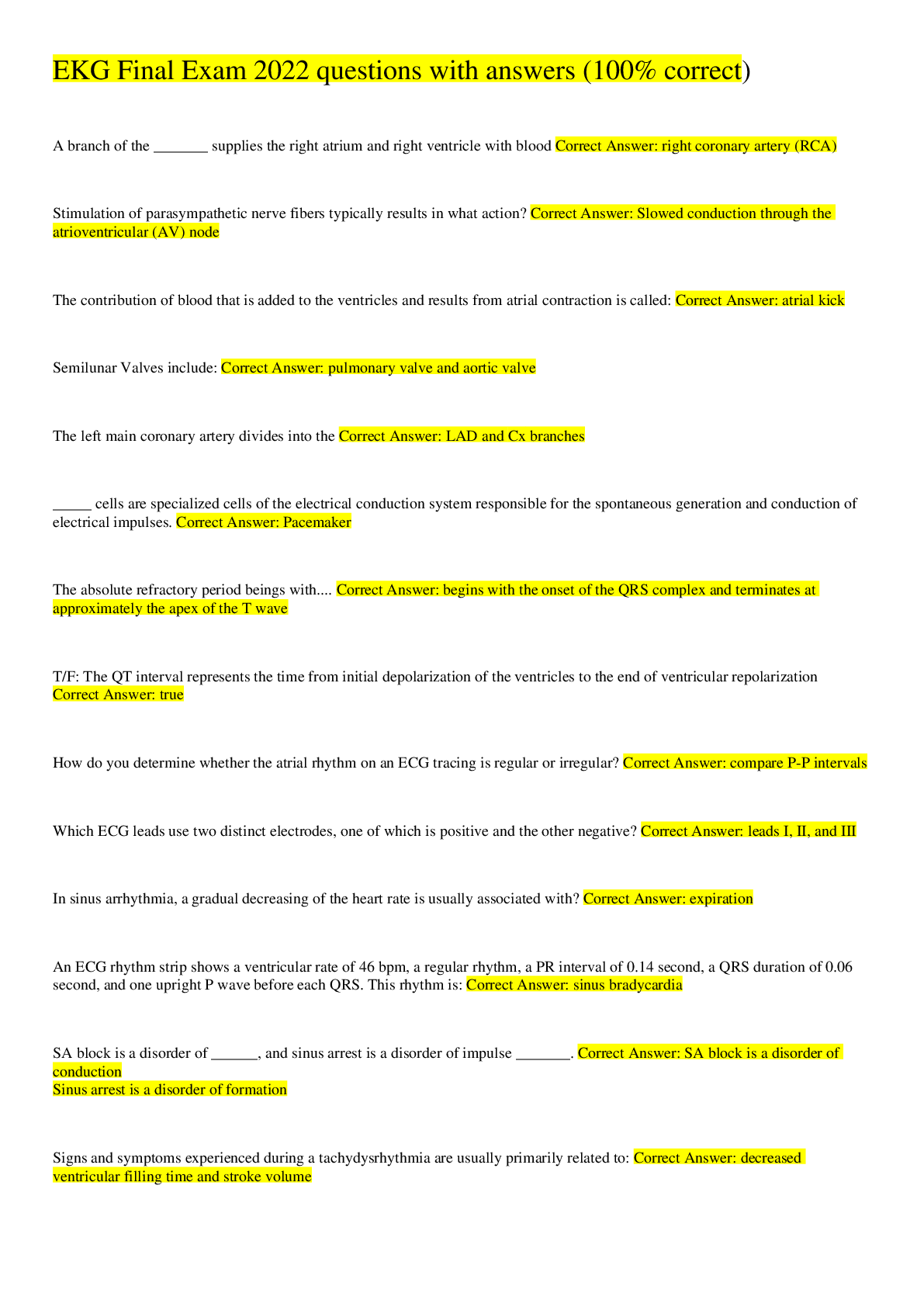
.png)
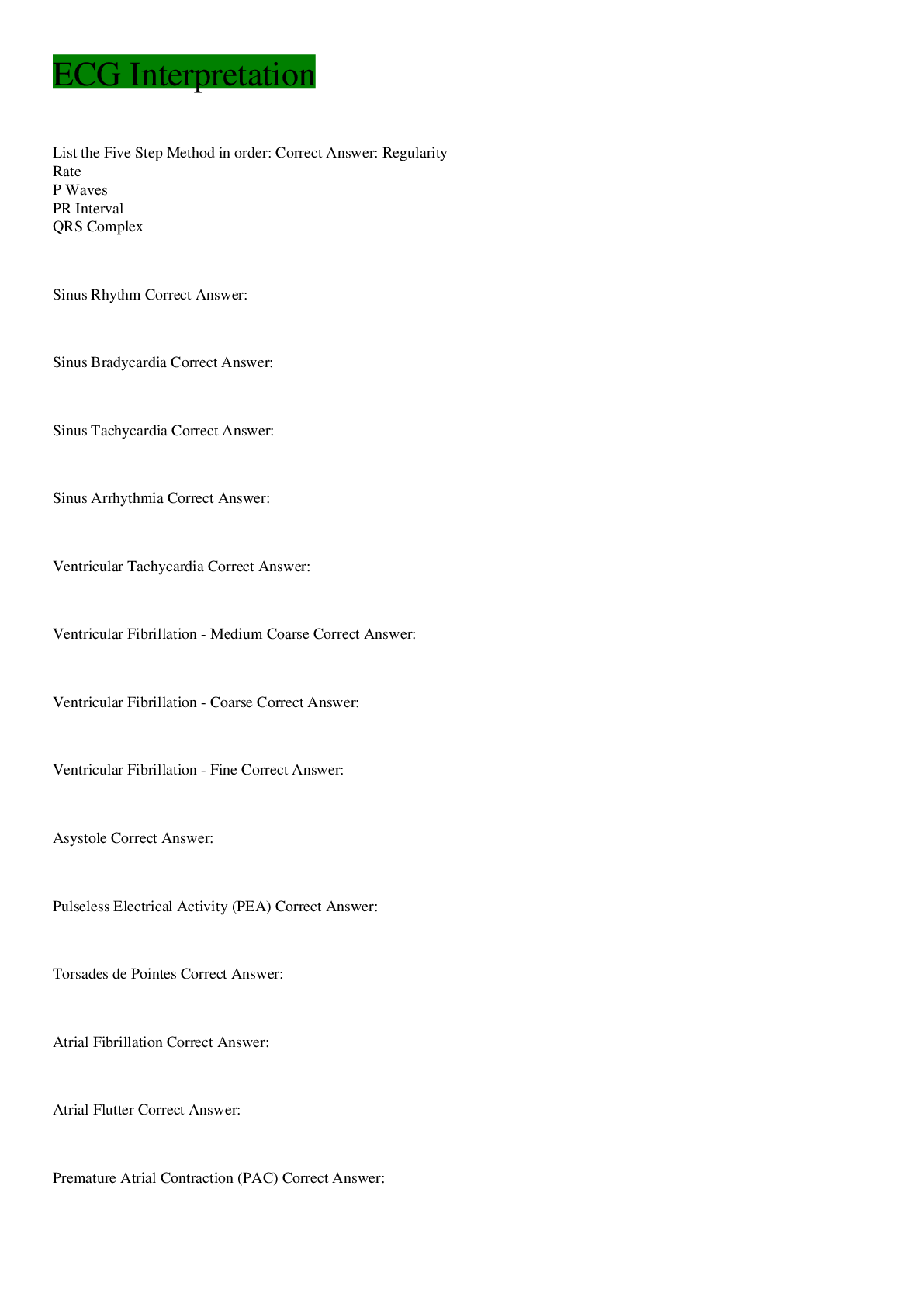
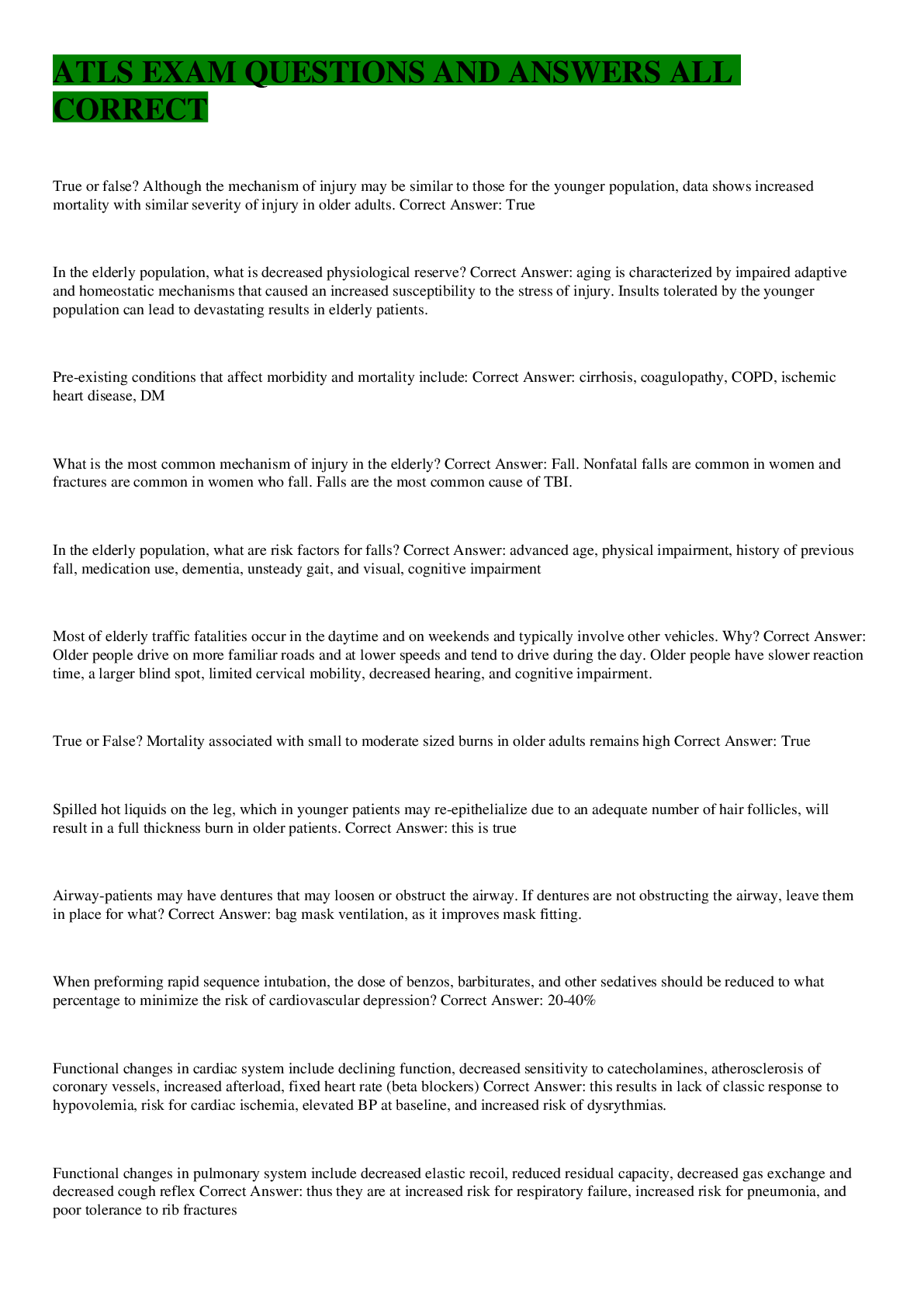
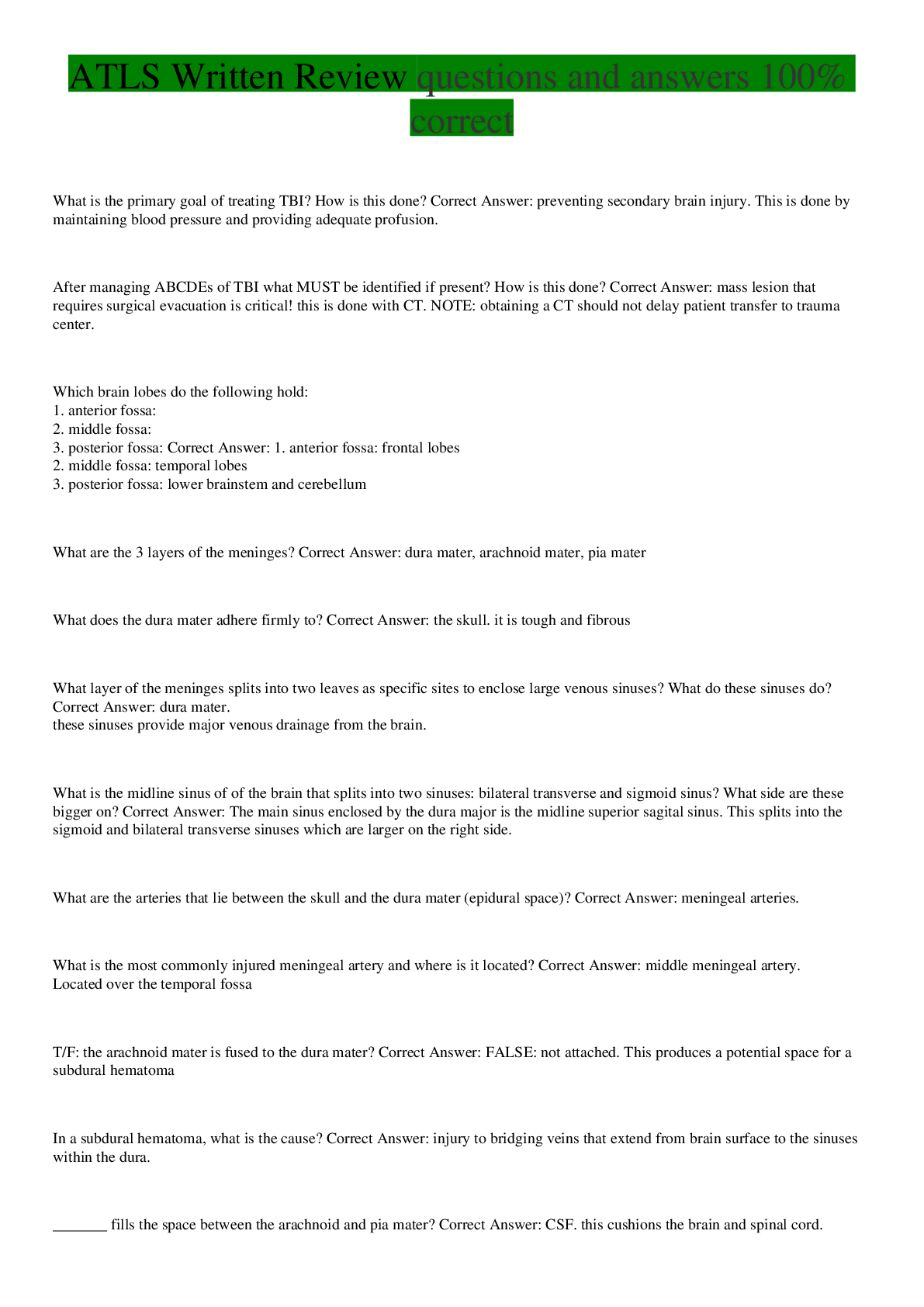
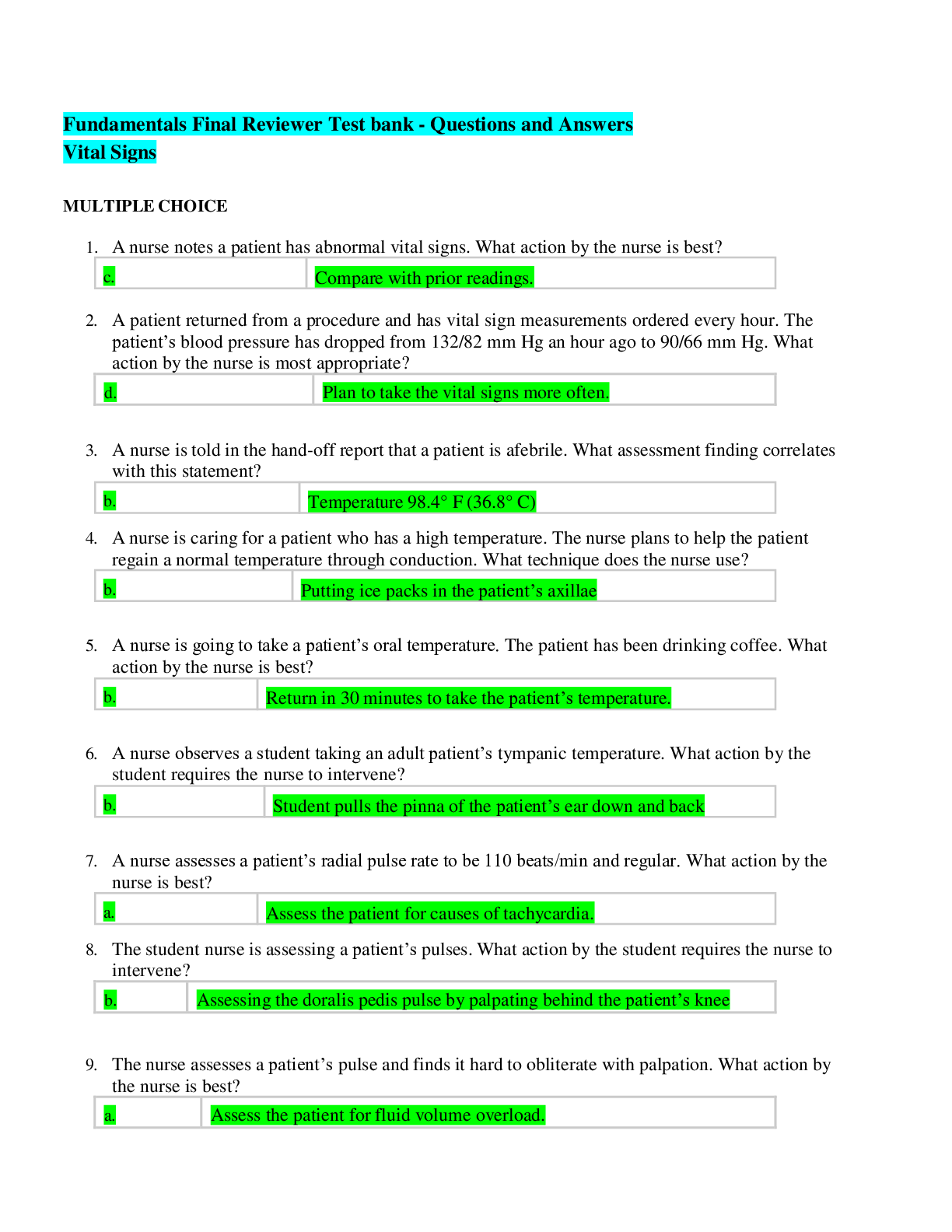
.png)
